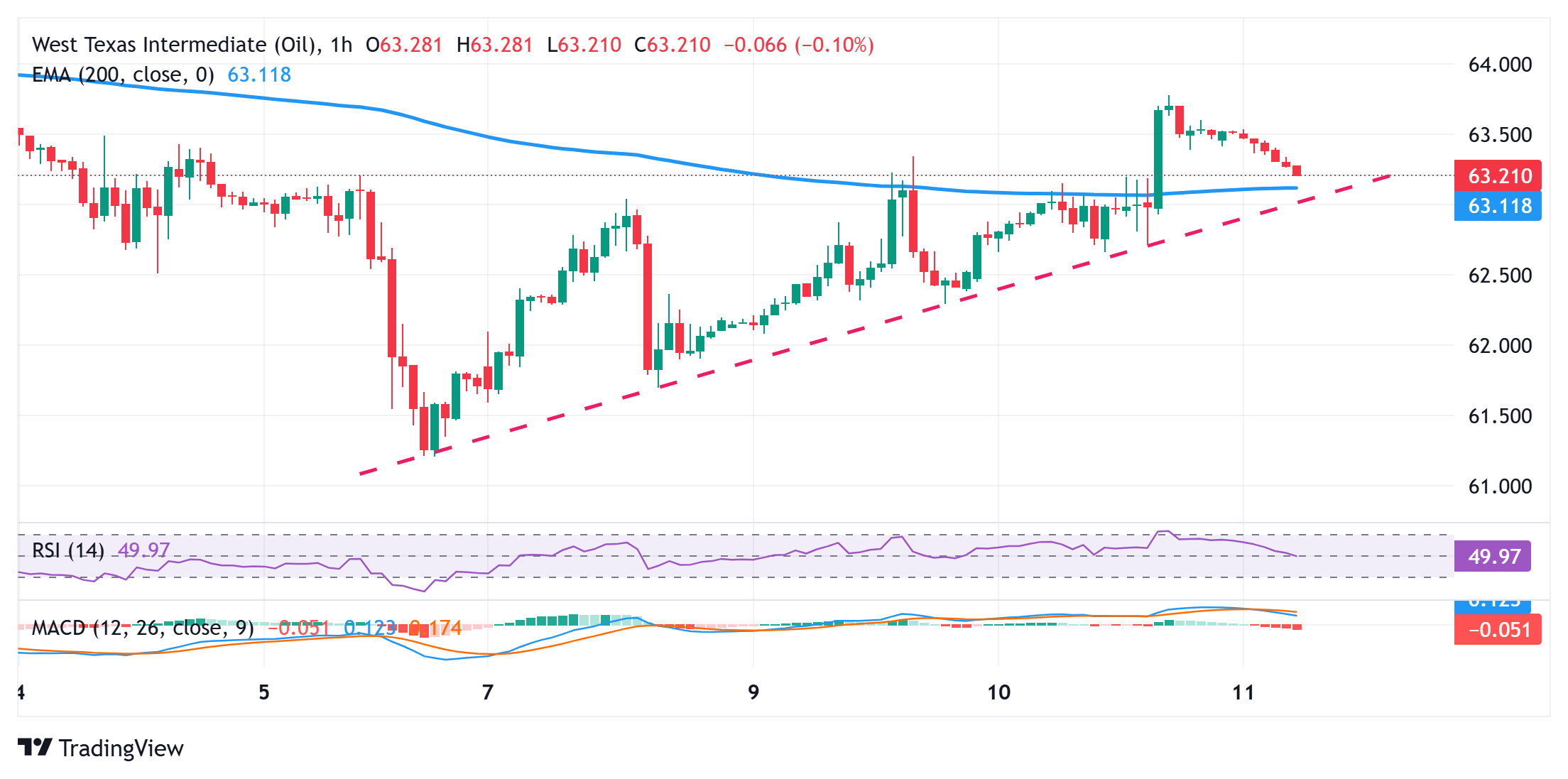WTI Price Forecast: Retreats from one-week high; $63.00 holds the key for bullish traders

- WTI attracts some sellers on Thursday and snaps a three-day winning streak to a one-week high.
- The technical setup backs the case for the emergence of dip-buyers near the $63.00 confluence.
- A sustained strength and acceptance above the $64.00 mark is needed to reaffirm positive bias.
West Texas Intermediate (WTI) US Crude Oil prices drift lower during the Asian session on Thursday and for now, seem to have snapped a three-day winning streak to a one-week high, around the $63.75-$63.80 region, touched the previous day. The black liquid currently trades around the $63.30-$63.25 zone, down 0.35% for the day.
The Energy Information Administration (EIA) reported an unexpected rise in US crude inventories on Wednesday, which, along with falling producer prices and a slowing labour market, points to softening fuel demand. Furthermore, the OPEC+ decision to raise production from October turned out to be a key factor exerting some pressure on Crude Oil prices. However, geopolitical risks stemming from the protracted Russia-Ukraine war and conflicts in the Middle East could help limit losses for the commodity.
From a technical perspective, the recent recovery from a three-month low, touched earlier this month, has been along an upward trend line. This, along with the previous day's breakout through the 200-hour Exponential Moving Average (EMA) and positive oscillators on hourly charts, backs the case for the emergence of dip-buying around Crude Oil prices. Hence, any further slide is more likely to find decent support near the 200-hour EMA and ascending trend-line confluence, around the $63.00 mark.
The said handle should act as a key pivotal point, which, if broken decisively, will negate the constructive outlook and drag Crude Oil prices to the next relevant support near the $62.65 region. Given that technical indicators on the daily chart are holding in negative territory, the black liquid could weaken further towards testing sub-$62.00 levels before eventually dropping to the multi-month low, around the $61.20 area, touched last Friday.
On the flip side, the $63.75-$63.80 region, or a one-week low set on Wednesday, could act as an immediate hurdle ahead of the $64.00 mark. A sustained strength beyond the latter would set the stage for a move towards the $64.50-$64.55 intermediate resistance en route to the $65.00 psychological mark. The momentum could extend further and eventually lift the black liquid to the monthly swing high, around the $65.75 zone.
WTI 1-hour chart

WTI Oil FAQs
WTI Oil is a type of Crude Oil sold on international markets. The WTI stands for West Texas Intermediate, one of three major types including Brent and Dubai Crude. WTI is also referred to as “light” and “sweet” because of its relatively low gravity and sulfur content respectively. It is considered a high quality Oil that is easily refined. It is sourced in the United States and distributed via the Cushing hub, which is considered “The Pipeline Crossroads of the World”. It is a benchmark for the Oil market and WTI price is frequently quoted in the media.
Like all assets, supply and demand are the key drivers of WTI Oil price. As such, global growth can be a driver of increased demand and vice versa for weak global growth. Political instability, wars, and sanctions can disrupt supply and impact prices. The decisions of OPEC, a group of major Oil-producing countries, is another key driver of price. The value of the US Dollar influences the price of WTI Crude Oil, since Oil is predominantly traded in US Dollars, thus a weaker US Dollar can make Oil more affordable and vice versa.
The weekly Oil inventory reports published by the American Petroleum Institute (API) and the Energy Information Agency (EIA) impact the price of WTI Oil. Changes in inventories reflect fluctuating supply and demand. If the data shows a drop in inventories it can indicate increased demand, pushing up Oil price. Higher inventories can reflect increased supply, pushing down prices. API’s report is published every Tuesday and EIA’s the day after. Their results are usually similar, falling within 1% of each other 75% of the time. The EIA data is considered more reliable, since it is a government agency.
OPEC (Organization of the Petroleum Exporting Countries) is a group of 12 Oil-producing nations who collectively decide production quotas for member countries at twice-yearly meetings. Their decisions often impact WTI Oil prices. When OPEC decides to lower quotas, it can tighten supply, pushing up Oil prices. When OPEC increases production, it has the opposite effect. OPEC+ refers to an expanded group that includes ten extra non-OPEC members, the most notable of which is Russia.






